|
|||||||||
Select any of 50 available languages! |
|||||||||
Grapefruit |
||
| Citrus × paradisi |
History World grapefruit production Uses Nutritional values White, pink and red varieties Colour of the peel Grapefruit White: Pink: Red: Grapefruit hybrids |
|
| 'Star Ruby' grapefruit © Jorma Koskinen |
White, pink and red varieties
|
| LAT | Citrus × paradisi Macfadyen |     |
| Syn | Citrus maxima var.
racemosa Osbeck |
|
Grapefruit is assumed to be an offspring of sweet orange as the
pollen parent with an unidentified variety harboring the pummelo cytotype: ♀unknown pummelo × ♂C. sinensis.
The grapefruit
tree reaches 15 to 20 ft (4.5-6 m) , has a rounded top of
spreading branches. The trunk may exceed 6 in (15 cm) in diameter. The
twigs normally bear short, supple thorns. The evergreen leaves are
ovate, 3 to 6 in (7.5-15 cm) long, and 1 3/4 to 3 in (4.5-7.5 cm) wide,
dark-green above, lighter beneath, with minute, rounded teeth on the
margins, and dotted with tiny oil glands. The petiole has broad,
oblanceolate or obovate wings. The fruit is nearly round or oblate to slightly pear-shaped, 4 to 6 in (10-15 cm) wide with smooth, finely dotted peel, up to 3/8 in (1 cm) thick, pale-lemon, sometimes blushed with pink. The pale-yellow, nearly whitish, or pink, or even deep-red pulp is in 11 to 14 segments with thin, membranous, somewhat bitter walls. The fruit is very juicy, acid to sweet-acid in flavour when fully ripe. While some fruits are seedless or nearly so, there may be up to 90 white, elliptical, pointed seeds about 1/2 in (1.25 cm) in length. Unlike those of the pummelo, grapefruit seeds are usually polyembryonic. The number of fruits in a cluster varies greatly; a dozen is unusual but there have been as many as 20. Please, note that in many languages grapefruit is called Pomelo, the English name of another species (Citrus maxima). In these languages the Pomelo of English is called with an equivalent of is French name Pamplemousse. |
||
| ENG | Grapefruit,
Western grapefruit, Common grapefruit |
|
| FRA | Pomelo | |
| GER | Pampelmuse | |
| I TA | Pompelmo, Pampelino | |
| ESP | Pomelo, Toronja, | |
| Photo | © Jorma Koskinen | |
| |
||
|
|
||
| LAT | Citrus × paradisi ’Duncan’ | 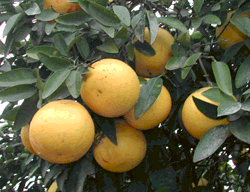  |
Duncan is the oldest of the modern commercially grown grapefruit varieties. Its earliest wild forms grew in Florida already in the 1830's. The commercial propagation of Duncan began in the 1890's. The flesh and juice are quite pale in colour but the taste is still considered to be one of the best of all grapefruit varieties and often serves as a benchmark by which new varieties are judged. Duncan was the most important cultivar in Florida and Texas for decades and was introduced into all grapefruit-growing areas the world over. After many seedless varieties emerged Duncan lost some of its popularity. Duncan is much used for juice and tinned in syrup as segments or fruit salads. |
||
| ENG | Duncan
grapefruit |
|
| FRA | Pomelo Duncan | |
| Photos | © UCR Citrus
Variety
Collection © C. Jacquemond / INRA |
|
| |
|
|
| LAT | Citrus × paradisi ’Marsh’ |   |
| Syn | Citrus × paradisi 'Marsh seedless' |
|
Marsh (Marsh seedless) was discovered in Florida as a spontaneous seedling in 1860. Because the fruit of the three original seedlings were seedless the new variety was propagated in a nursery and Marsh soon became the most popular new cultivar to be planted. Today Marsh is the leading variety not only in Florida where it originated but also in California, Texas, Arizona, South America, Australia, South Africa, Israel and India. The fruit is almost completely round, very juicy and rich in flavour. Marsh is medium to late in the season, holds well on the tree and keeps well after harvest. Marsh needs a lot of heat and thrives in hot climates. It also highly sensitive to frost. |
||
| ENG | Marsh
(seedless) grapefruit |
|
| FRA | Pomelo Marsh | |
| Photos | © Aggie Horticulture TAMU © Jorma Koskinen |
|
| |
||
| LAT | Citrus × paradisi ’Melogold’ | 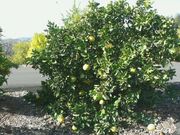   |
| Syn | Citrus maxima 'Siamese Sweet' × (Citrus × paradisi '4n Marsh') | |
Melogold is a sister hybrid of Oroblanco (next below). They both are hybrids of an acidless Siamese Sweet pomelo and a strain of Marsh grapefruit. The cross was made in 1958, they were field-planted in 1962. Two cultivars showed special characteristics. The first one was released in 1980 as Oroblanco and the second in 1986 as Melogold. Information from the UC-Riverside Citrus Variety Collection: Melogold trees grow vigorously to a large size with a somewhat spreading form. Melogold fruits are oblate in form with a slightly flattened base. The rind is smooth and medium to dark yellow at maturity and thinner than Oroblanco for a similarly sized fruit. The large fruits typically average one pound in weight. The flesh is pale yellow in colour, seedless, tender, and juicy. The flavour is mild, sweet and reminiscent more of pomelo than of grapefruit. Melogold is early in its maturity and holds well on the tree. |
||
| ENG | Melogold
grapefruit |
|
| FRA | Pomelo Melogold | |
| Photos | (1) © Gene Lester (2-3) © Jorma Koskinen |
|
|
|
||
| LAT | Citrus × paradisi ’Oroblanco’ |   |
| Syn | Citrus maxima 'Siamese
Sweet' x
Citrus
paradisi '4n Marsh' Citrus maxima ’Sweetie’ |
|
Oroblanco is one of the newest grapefruit varieties. One of its parents is the Siamese Sweet pomelo, the other is a Marsh variety growing at the Research Center of the University of California, Riverside. The cross was made in 1958 and Oroblanco was released for sale in 1980. The taste is sweet, the flesh pale yellow and seedless. Oroblanco matures early in November - December, and holds well on the tree. A similar cross made in Israel was released for sale in 1984 under the name 'Sweetie' (see below). These hybrids belong to the varieties that can retain a touch of green even when fully ripe. The Israeli 'Sweetie' can remain dark green, but tastes sweet nonetheless. |
||
| ENG | Oroblanco
grapefruit, Sweetie |
|
| FRA | Pomelo Oroblanco, Sweetie | |
| Photos | © Jorma Koskinen © Gene Lester |
|
|
|
||
| LAT | Citrus × paradisi ’Jaffa Sweetie’ |
 |
(Citrus × paradisi) × Citrus maxima |
||
Jaffa Sweetie is a similar cross to the preceding Oroblanco. It is a cross of grapefruit and pomelo made in Israel and released for sale in 1984. The shape and juiciness of the fruit resembles grapefruit, but it tastes as sweet as a pomelo. The skin is dark green in the beginning of the season, and it gradually changes to bright yellow. The fruit is unique by being sweet, yet low on calories (between 24 to 40 calories in one fruit). The reason is that the sweetness does not come from an excess of sugar, but from lack of acid. Ripe from mid September to March. |
||
| Photos | © Jorma Koskinen | |
| |
||
| LAT | Citrus × paradisi ’Foster’ |  |
Foster pink originated as a limb sport in a tree of the Walters variety in an orchard near Ellenton, Florida, and was discovered in 1907 by R. B. Foster of nearby Manatee. It was introduced in 1914 by the Royal Palms Nurseries, Oneco. Fruit medium-large, oblate to spherical; basal furrows short, radiating; areolar ring indistinct; very seedy. Primary colour pale to light yellow, but under favourable conditions rind blushed with pink, extending into the albedo. Rind medium-thick and surface smooth. Primary flesh colour chamois, but under favourable conditions pink; flesh texture tender and juicy; flavour good. Medium-early in maturity. Tree is vigorous, large, and productive. |
||
| ENG | Foster
grapefruit |
|
| FRA | Pomelo Foster | |
| Photo | © Aggie Horticulture TAMU | |
|
|
||
| LAT | Citrus × paradisi ’Henderson’ |  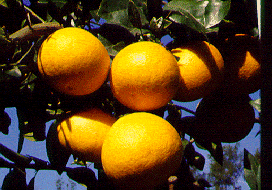  |
In 1929 frost destroyed the crops of many Texas plantations. The severe weather killed many trees but some started growing again in the spring of the following year. One of these new sprouts produced fruit with a beautiful ruby colour. A new variety was born. 'Henderson' is very productive. Some of the best trees can produce 250 seedless fruits a year. Henderson requires effective irrigation but tolerates high temperatures well. Henderson and Ray Ruby apparently are indistinguishable cultivars discovered in the early 1970s, Henderson as a limb sport of an Everhard strain red grapefruit tree originally planted in 1945 and Ray as four separate young trees planted in a Ruby Red orchard. Both are commercially seedless, of excellent quality and acceptable for gift, fresh and processed markets. Both have more rind blush and two to four times redder flesh color than Ruby Red, with flesh color holding well into late season. Both belong to the Ruby Sweet group together with Ruby Red. The South African 'Flamingo' grapefruit is an induced mutation of from the Henderson grapefruit and belongs to the strongly pigmented varieties but of slightly lighter colour than Star Ruby. |
||
| ENG | Henderson grapefruit
|
|
| FRA | Pomelo Henderson | |
| Photos | © CCPP © C. Jacquemond / INRA © Aggie Horticulture TAMU |
|
|
|
||
| LAT | Citrus × paradisi 'Marsh Pink ' |  |
| Syn | Citrus × paradisi 'Thompson' |
|
Marsh Pink (Thompson) originated as a limb sport in a Marsh tree in an orchard owned by W. B. Thompson at Oneco, Florida. While discovered by S. A. Collins in 1913, it did not become available until 1924 when it was named and introduced by the Royal Palms Nurseries, also of Oneco. Thompson remains of horticultural interest because it was the first seedless pigmented variety to be discovered. However, other seedless cultivars with superior flesh and peel color were soon discovered and planted in favor of 'Thompson'. Fruit characteristics are essentially identical to 'Marsh' with the exception of the pink flesh color. Sugar and acid levels may be lower than 'Marsh', but not meaningfully so. Fruit hold well on the tree, but flesh color fades as the season progresses. |
||
| ENG | Marsh
Pink grapefruit, Thompson grapefruit |
|
| FRA | Pomelo Marsh Pink | |
| Photo | © Aggie Horticulture TAMU | |
|
|
||
| LAT | Citrus × paradisi 'Ray Ruby ' |   |
|
Ray Ruby was first observed growing in a Texas grove of 'Redblush' (Ruby Red) grapefruit. 'Ray Ruby' is comparable to 'Redblush' in many respects. Juice and seed content, flesh texture and maturity date are similar for these two cultivars. However, internal colour holds well late in the season for 'Ray Ruby', and greater blush is usually noted for this cultivar than for 'Redblush'. Texas trials suggest that yields and growth characteristics are similar to 'Redblush'. However, no yield data are available for 'Ray Ruby' in Florida where it is recommended only for trial use. Henderson
and Ray Ruby apparently are indistinguishable cultivars discovered in
the early 1970s, Henderson as a limb sport of an Everhard strain red
grapefruit tree originally planted in 1945 and Ray as four separate
young trees planted in a Ruby Red orchard. Both are commercially
seedless, of excellent quality and acceptable for gift, fresh and
processed markets. Both have more rind blush and two to four times
redder flesh color than Ruby Red, with flesh color holding well into
late season. |
||
| ENG | Ray
Ruby grapefruit |
|
| FRA | Pomelo Ray Ruby | |
| Photo | © CCPP | |
|
|
||
| LAT | Citrus × paradisi ’Redblush’ |    |
| Citrus × paradisi 'Ruby Red' Citrus × paradisi 'Ruby Sweet' |
||
Redblush or Ruby Red was the leading red grapefruit in Texas for nearly four decades and it is the variety on which Texas' reputation for quality is based. It is said to be a limbsport of the Thompson variety and it was found in Texas in 1929. It is commercially seedless, may have a red blush on the rind and has excellent quality. The early redness of the flesh gradually fades to pink by midseason and buff by spring. Ruby Red is well-suited for gift fruit, fresh market and processing. This was the first citrus fruit variety that was patended (1934). In Texas Ruby Red belongs to the Ruby Sweet group of grapefruit together with Henderson and Ray Ruby. |
||
| ENG | Ruby
Red grapefruit, Ruby Sweet grapefruit, Red Blush grapefruit |
|
| FRA | Pomelo Ruby Red | |
| Photo | © Jorma Koskinen | |
|
|
|
|
| LAT | Citrus × paradisi 'Shambar ' |   |
Shambar is an old seedless pigmented variety of grapefruit. Its pink flesh resembles the colour of Redblush (Ruby). In suitable conditions Shambar matures earlier than Marsh and sometimes has stronger colour and more flavour than Redblush. Shambar was discoverd already in 1936 at Corona, California as a limb sport of the Marsh variety. It was introduced in 1945 but has not received wide popularity. Recently however, its production qualities have received some attention due to findings in comparative studies and Shambar has been evaluated in several countries in the Mediterranean basin. In a 2008 study of grapefruit varieties suitable for tropical conditions (Colima, Mexico) Shambar was found to be among the top four performers for best productivity and fruit colour. The other three were Rio Red, Ray Ruby and Redblush. |
||
| ENG | Shambar grapefruit |
|
| FRA | Pomelo Shambar | |
| Photo | © Jorma Koskinen | |
|
|
||
| LAT | Citrus × paradisi 'Flame' |  |
Flame grapefruit is reported to be from seed of a sport of Ruby Red grapefruit originating in the Houston, Texas grove of C. Henderson. C. J. Hearn made the final selection, and Flame was released as a new variety in 1987. Flame trees grow vigorously to a large size and are reported to be more cold-tolerant than Star Ruby. The fruit has a smooth yellow rind and usually has a pink blush. The flesh is tender and juicy and has an internal colour almost as dark as Star Ruby. Flame’s season is mid to late-season; the fruit holds well on the tree with some fading of the internal colour when held past maturity. Season: February to June |
||
| ENG | Flame
grapefruit |
|
| FRA | Pomelo Flame | |
| Photo | © Joe Real | |
|
|
||
| LAT | Citrus × paradisi ’Rio Red’ |    |
| |
||
'Rio Red' was originally a branch sport of 'Ruby'. Its characteristics were retained by the next generation. Rio Red thrives in a hot climate. The fruit is large and often shows some red pigment on the rind. The flesh and juice have a beautiful red colour. Rio Red was released by Texas A&I University in 1984 as a natural mutation on a tree produced from irradiated budwood which came from Ruby Red seedlings. Tested by Texas A&I University as A&I-1-48S, it produces fruit with a rind color similar to Henderson and Ray and flesh color almost as red as Star Ruby. Other fruit and tree characteristics are similar to Ruby Red except that its deep red flesh color persists throughout the season and it has a strong tendency to sheepnosing. It is a heavy bearer, with a slight tendency to alternation, i.e., exceptionally large crops are often followed by what would normally be considered an average crop. Rio Red is suitable for gift, fresh and processed markets. As sold in Texas Rio Star grapefruit are the super-red or deep-red fleshed grapefruit of Star Ruby and Rio Red varieties, which comprise about 75 percent of Texas grapefruit acreage. Very few, if any, Star Ruby orchards exist, however, so virtually all of the Rio Star grapefruit in Texas are Rio Red. |
||
| ENG | Rio
Red grapefruit |
|
| FRA | Pomelo Rio Red | |
| Photo | (1-2) © Jorma Koskinen © Aggie Horticulture TAMU |
|
|
|
|
|
| LAT | Citrus × paradisi ’Star Ruby’ |     |
| Syn | Citrus × paradisi 'Sunrise' (see next item) |
|
Star Ruby (Rio Star) from Texas is a demanding variety to grow. It needs steady heat and humidity but does not tolerate extreme high heat or drought. It is susceptible to infections, pests and cold weather. It is less vigorous than other varieties, grows slowly and the tree and fruit remain smaller than other grapefruit types. However, in suitable conditions the tree produces attractive red blushed fruit. The flesh and juice are strongly pigmented, up to three times more colourful than 'Ruby Red', and have a bit more sugar and acid. The fruit is low-seeded or seedless and has a very good flavour. Rio Star grapefruit are the super-red or deep-red fleshed grapefruit of Star Ruby and Rio Red varieties, which comprise about 75 percent of Texas grapefruit acreage. Very few, if any, Star Ruby orchards exist, however, so virtually all of the Rio Star grapefruit is Rio Red. Star Ruby was released by Texas A&I University in 1970, having originated from irradiated seed of Hudson grapefruit. Its primary attributes are intensely red flesh, good color retention even in late season and a fairly uniform red blush on the rind. Star Ruby commanded good market acceptance and premium prices, but it is sensitive to some herbicides, frequently exhibits winter chlorosis and apparently is more susceptible to Phytophthora and cold damage than other cultivars. Star Ruby is also noted for erratic bearing. Because of its inherent production problems, the freezes of 1983 and 1989 and the introduction of Rio Red in 1984, Star Ruby has essentially disappeared from the Texas industry. |
||
| ENG | (Texas)
Star Ruby grapefruit |
|
| FRA | Pomelo Star Ruby | |
| Photo | © Jorma Koskinen |
|
|
|
|
|
Grapefruit hybrids
Orangelos and more
| Orangelos are hybrids of grapefruit and orange. As might be expected these often natural hybrids show characteristics of both parents to various degrees. Chironja is more grapefruit-like whereas Poorman shows more signs of orange. Sometimes even such established old grapefruit varieties as Imperial, Royal and Triumph are considered natural hybrids with orange. The parentage of Wheeny and Smooth Flat Seville is debated but both show many characteristics of orangelos and Smooth Flat Seville is included here in grapefruit hybrids. Rex Union shows all the characteristics of an orangelo but is reportedly a hybrid of Seville orange and a pomelo. Cocktail is a complicated hybrid of two mandarins and a pomelo. |
| LAT | Citrus × paradisi 'Chironja ' |   |
| Syn | ||
Chironja comes from Puerto Rico and exhibits resemblances to both the orange and grapefruit, particularly to the latter. The name is a combination of Chi(na), the local term used for the sweet orange, and (to)ronja, the Spanish word for grapefruit. Chironja was found in 1956 as a wild seedling tree in the mountainous section Puerto Rico. Later other seedling trees were found in isolated areas of the coffee zone. The fruit is large (grapefruit size) and has a few seeds. Rind is medium-thin, smooth, moderately adherent but easily peelable. Segments about 10, central axis medium-large and semi-open. Flesh is yellowish-orange, tender and very juicy. The flavour is mild, lacking the bitterness of the grapefruit. Midseason in maturity and fruit holds well on tree. Tree is vigorous, large, and grapefruit-like; leaves broadly winged, somewhat cupped, and margins irregularly undulate. Unlike true grapefruits where fruit grow in large clusters, the fruit of Chironja are borne singly. |
||
| ENG | Chironja
orangelo |
|
| FRA | ||
| Photos | © Gene Lester | |
|
|
||
| LAT | Citrus × paradisi 'New Zealand Grapefruit ' |  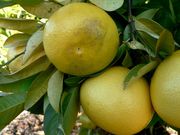 |
| Syn | Poorman Orange |
|
|
A seedy, orange-fleshed fruit that matures slightly earlier than grapefruit because of its lower acidity. It is known by various names, including 'New Zealand Grapefruit', and 'Poorman Orange'. The fruit and tree are very similar to grapefruit, but it is probably a pomelo hybrid or a natural tangelo that may have originated in China or Australia. This is also suggested by the monoembryony of the seeds (they will not grow true to type). The fruit has some resemblance to the Attani of India and the Natsudaidai and Asahikun of Japan. A total heat requirement considerably lower than for any of the true grapefruits is indicated by the earlier maturity of Poorman and the fact that it ripens in New Zealand and parts of southern California where there is insufficient heat for any of the regular grapefruit varieties. |
||
| ENG | New
Zealand Grapefruit, Poorman, Poorman's orange, Kawau, Sun fruit |
|
| FRA | Tangelo Poorman |
|
| Photos | © Aggie Horticulture TAMU © Gene Lester |
|
|
|
||
| LAT | Citrus × paradisi 'Rex Union' |  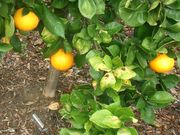 |
Rex Union was found around 1930 in South Africa. It has never been commercially grown. The exact origin of this variety has not been established but it is believed to be a naturally occured hybrid of Seville orange and pomelo. The external colour is strong orange and the internal colour also exhibits a shade of pale orange when fully ripe. Fruit are large, normal grapefruit size. Tree is medium-size and compact. The fruit tend to hang on the lower limbs. The UCR CVC website reports that Rex Union makes excellent marmalade because it is not necessary to peel the fruit. You just cut the whole fruit into pieces and boil it in a sugar and water mixture. |
||
| ENG | Rex Union grapefruit |
|
| FRA | Pomelo Rex Union | |
| Photo | © Jorma Koskinen | |
|
|
||
| LAT | Citrus × paradisi 'Smooth Flat Seville ' |   |
| Syn | Citrus × paradisi 'Smooth
Seville' |
|
Smooth Flat Seville is an old Australian fruit that is thought to have originated as a seedling of unknown parentage and has generally been regarded as a sweet orange and grapefruit hybrid. Its age and numerous resemblances to Poorman (New Zealand Grapefruit above), however, suggest that it may be of similar origin and possibly a sister seedling. Fruit is similar to Poorman in size, form, and flavour, but rind surface is very smooth. Both rind and flesh colour is reddish-orange. Tree and foliage similar to Poorman but tree commonly more vigorous and larger. Younger branches also exhibit dark bark streaks characteristic of Poorman. Like Poorman, Smooth Seville has a lower heat requirement for maturity than the grapefruit and hence ripens earlier and serves as a satisfactory substitute. |
||
| ENG | Smooth
Flat Seville, Smooth Seville |
|
| FRA | ||
| Photos | © Gene Lester | |
|
|
||
| LAT | Citrus × paradisi 'Triumph ' |   |
| Syn | ||
Triumph was the first named grapefruit variety. It was released in 1884 and soon became very popular and a much-planted variety. The parent tree was found near the Orange Grove Hotel in Tampa, Florida. It was soon suspected that the seedling tree was a hybrid, perhaps an orange - grapefruit hybrid, a natural orangelo. Triumph lacks the bitterness of a typical grapefruit and the taste has a strong sweet orange flavour. The seedy, pale yellow, medium-sized fruit are a little flattened both at the top and bottom. With the subsequent arrival of seedless grapefruit varieties Triumph has lost popularity. Triumph never achieved commercial importance but continues to be planted in private orchards for home use. The strong flavour remains exceptional. The Jackson LS (low-seeded) variety of South Africa is said to be a seedless budsport of Triumph. It is marketed under the Sweet SunriseTM name. |
||
| ENG | Triumph grapefruit |
|
| FRA | Pomelo Triumph |
|
| Photos | © Jorma Koskinen | |
|
|
||
| LAT | Citrus × paradisi ‘Cocktail’ | 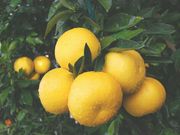    |
| Syn | Citrus maxima 'Siamese Sweet' × Citrus reticulata 'Frua' |
|
|
Although called a grapefruit Cocktail is actually a hybrid of Siamese Sweet pomelo and Frua mandarin, which is a cross of King mandarin and Dancy tangerine. To be precise Cocktail is 1/4 King mandarin, 1/4 Dancy tangerine and 2/4 Siamese Sweet pomelo, which explains its other name Mandalo.
|
||
| ENG | Cocktail
grapefruit |
|
| FRA | Pomelo Cocktail | |
| Photo | (1-2) © Joe Real (3) © Gene Lester (4) © Jorma Koskinen |
|
| |
||
| Reference: Performance of various grapefruit (Citrus paradisi Macf.) and pummelo (C. maxima Merr.) cultivars under the dry tropic conditions of Mexico Becerra-Rodríguez Salvador (1) ; Medina-Urrutia Víctor Manuel (1) ; Robles-González Marciano Manuel (1) ; Williams Timothy (2) (1) INIFAP-Campo Experimental Tecomán, CP 28100, Tecoman, Mexico (2) Department of Botany and Plant Sciences, University of California, CA, Riverside, USA Euphytica Y. 2008, vol. 164, No. 1, pages 27-36 [10 pages] [bibl. : 3/4 p.] |

|
|


